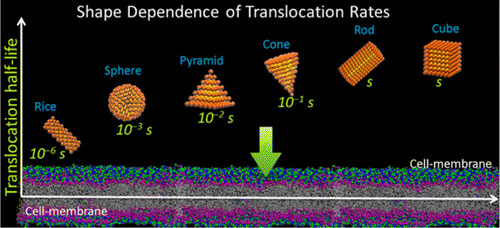| Jan 24, 2013 |
Modifications of a nanoparticle can change chemical interactions with cell membranes
|
|
(Nanowerk News) Researchers at Syracuse University’s Department of Biomedical and Chemical Engineering at L.C. Smith College of Engineering and Computer Science are studying the toxicity of commonly used nanoparticles, particles up to one million times smaller than a millimeter that could potentially penetrate and damage cell membranes.
|
|
In a recent article published along with cover art in the leading journal Langmuir entitled “Effects of nanoparticle charge and shape anisotropy on translocation through cell membranes”, researchers Shikha Nangia, assistant professor of biomedical and chemical engineering (BMCE), and Radhakrishna Sureshkumar, Department Chair of BMCE and professor of physics, showed how simple shape and charge modifications of a nanoparticle can cause tremendous changes in the chemical interactions between the nanoparticle and a cell membrane.
|
 |
| The computed results indicate that depending on the nanoparticle shape and surface functionalization charge, the translocation rates can span 60 orders of magnitude. Unlike isotropic nanoparticles, positively charged, faceted, rice-shaped nanoparticles undergo electrostatics-driven reorientation in the vicinity of the membrane to maximize their contact area and translocate instantaneously, disrupting lipid self-assembly and thereby causing significant membrane damage. (© ACS)
|
|
Nanomaterials, which are currently being used as drug carriers, also pose a legitimate concern, since no universal standards exist to educate and fully protect those who handle these materials. Nanoparticles are comparable to chemicals in their potential threat because they could easily penetrate the skin or be inhaled.
|
|
“Nanotechnology has immense potential that is starting to be being realized; a comprehensive understanding of toxicity of nanoparticles will help develop better safe handling procedures in nanomanufacturing and nano-biotechnology” says Sureshkumar and Nangia, In addition, the toxicity levels of various nanoparticles can be used to our advantage in targeting cancer cells and absorbing radiation during cancer therapy. Nanotoxicity is becoming a major concern as the use of nanoparticles in imaging, therapeutics, diagnostics, catalysis, sensing and energy harvesting continues to grow dramatically.
|
|
This research project has taken place over the past year utilizing a state of the art 448 core parallel computer nicknamed “Prophet” housed in Syracuse University’s Green Data Center. The research was funded by the National Science Foundation.
|

